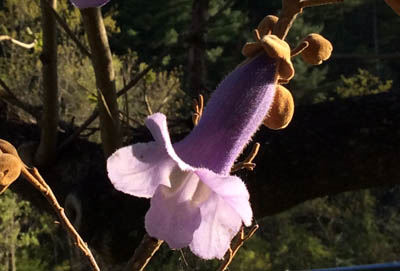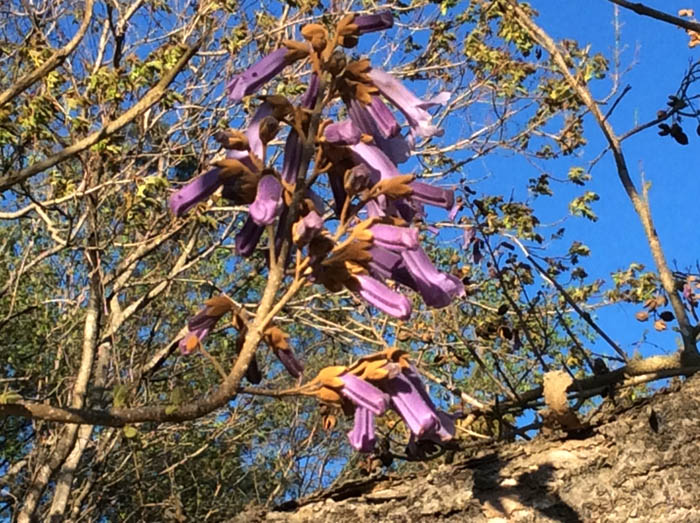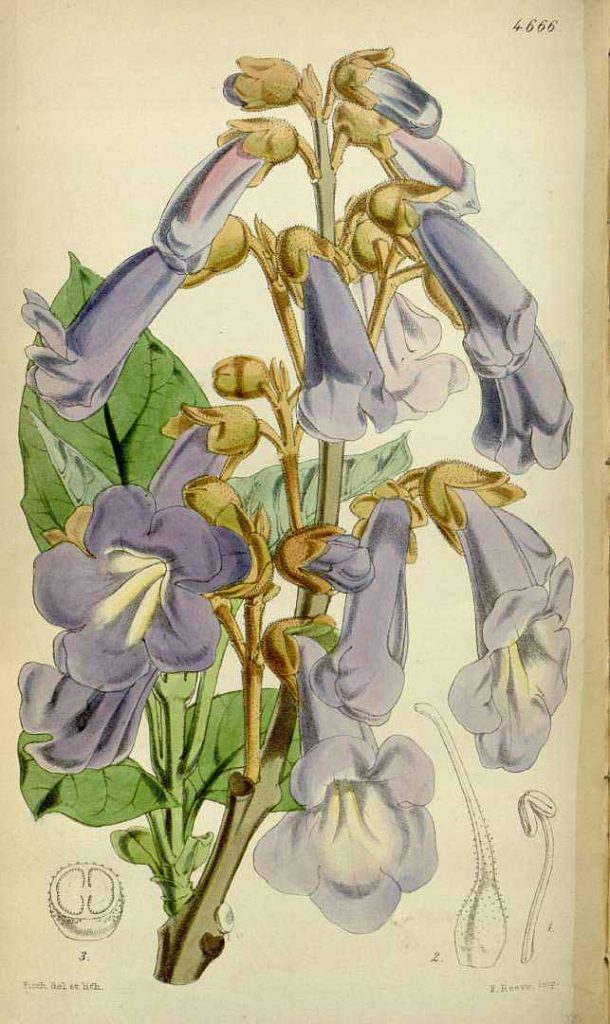
04.24.20 Princess Bride
 Prized for its unique wood, the Princess Tree, Paulownia tomentosa, was first introduced to me with the statement, “if you have these on your land, you could make a lot of money…” As a young man just learning about the trees and flowers of the Appalachians, I would see the dramatic flowers of this tree along highways and in waste areas. Its exotic purple flowers fascinated me. Appearing before the leaves, the tree makes a stunning sight when covered with blossoms. Doing online research for this post, I learned that, indeed, the Paulownia is prized for its lumber. It turns out that this tree is one of the fastest growing hardwoods, reportedly producing wood ready for harvest in as few as five years! It must be a wonderful tree for coppicing, as it grows back after hard pruning. Equally admirable is the wood’s resistance to rot. This flowering tree has a special place in Japanese culture. Not only is it used as a model for the prime minister’s mon (official emblem), but the tradition is to plant a paulownia at the birth of a daughter. By the time she is old enough to marry, the tree can be harvested and carved into precious items for her dowry. In spite of its ubiquity in our area, this tree is not native. It appeared in North America during the 19th century when its fluffy seeds were being used as packing material in crates shipped from Asia. I look for its brightly colored flowers every April, during the summer I notice tall single-stemmed saplings adorned with large heart-shaped leaves sprouting from cracks in sidewalks and next to old buildings. I used a photo of a paulownia sapling growing up through a farmer’s abandoned iron hay rake as the theme for a woodcut illustrating a broadside by Wendell Berry. Wendell’s poem described the eager energy with which the forest is ready to reclaim abandoned farm land.
Prized for its unique wood, the Princess Tree, Paulownia tomentosa, was first introduced to me with the statement, “if you have these on your land, you could make a lot of money…” As a young man just learning about the trees and flowers of the Appalachians, I would see the dramatic flowers of this tree along highways and in waste areas. Its exotic purple flowers fascinated me. Appearing before the leaves, the tree makes a stunning sight when covered with blossoms. Doing online research for this post, I learned that, indeed, the Paulownia is prized for its lumber. It turns out that this tree is one of the fastest growing hardwoods, reportedly producing wood ready for harvest in as few as five years! It must be a wonderful tree for coppicing, as it grows back after hard pruning. Equally admirable is the wood’s resistance to rot. This flowering tree has a special place in Japanese culture. Not only is it used as a model for the prime minister’s mon (official emblem), but the tradition is to plant a paulownia at the birth of a daughter. By the time she is old enough to marry, the tree can be harvested and carved into precious items for her dowry. In spite of its ubiquity in our area, this tree is not native. It appeared in North America during the 19th century when its fluffy seeds were being used as packing material in crates shipped from Asia. I look for its brightly colored flowers every April, during the summer I notice tall single-stemmed saplings adorned with large heart-shaped leaves sprouting from cracks in sidewalks and next to old buildings. I used a photo of a paulownia sapling growing up through a farmer’s abandoned iron hay rake as the theme for a woodcut illustrating a broadside by Wendell Berry. Wendell’s poem described the eager energy with which the forest is ready to reclaim abandoned farm land.
 Illustration of paulownia blossoms from Curtis’ Botanical Magazine.
Illustration of paulownia blossoms from Curtis’ Botanical Magazine.
 Josef Beery
Josef Beery Prized for its unique wood, the Princess Tree, Paulownia tomentosa, was first introduced to me with the statement, “if you have these on your land, you could make a lot of money…” As a young man just learning about the trees and flowers of the Appalachians, I would see the dramatic flowers of this tree along highways and in waste areas. Its exotic purple flowers fascinated me. Appearing before the leaves, the tree makes a stunning sight when covered with blossoms. Doing online research for this post, I learned that, indeed, the Paulownia is prized for its lumber. It turns out that this tree is one of the fastest growing hardwoods, reportedly producing wood ready for harvest in as few as five years! It must be a wonderful tree for coppicing, as it grows back after hard pruning. Equally admirable is the wood’s resistance to rot. This flowering tree has a special place in Japanese culture. Not only is it used as a model for the prime minister’s mon (official emblem), but the tradition is to plant a paulownia at the birth of a daughter. By the time she is old enough to marry, the tree can be harvested and carved into precious items for her dowry. In spite of its ubiquity in our area, this tree is not native. It appeared in North America during the 19th century when its fluffy seeds were being used as packing material in crates shipped from Asia. I look for its brightly colored flowers every April, during the summer I notice tall single-stemmed saplings adorned with large heart-shaped leaves sprouting from cracks in sidewalks and next to old buildings. I used a photo of a paulownia sapling growing up through a farmer’s abandoned iron hay rake as the theme for a woodcut illustrating a broadside by Wendell Berry. Wendell’s poem described the eager energy with which the forest is ready to reclaim abandoned farm land.
Prized for its unique wood, the Princess Tree, Paulownia tomentosa, was first introduced to me with the statement, “if you have these on your land, you could make a lot of money…” As a young man just learning about the trees and flowers of the Appalachians, I would see the dramatic flowers of this tree along highways and in waste areas. Its exotic purple flowers fascinated me. Appearing before the leaves, the tree makes a stunning sight when covered with blossoms. Doing online research for this post, I learned that, indeed, the Paulownia is prized for its lumber. It turns out that this tree is one of the fastest growing hardwoods, reportedly producing wood ready for harvest in as few as five years! It must be a wonderful tree for coppicing, as it grows back after hard pruning. Equally admirable is the wood’s resistance to rot. This flowering tree has a special place in Japanese culture. Not only is it used as a model for the prime minister’s mon (official emblem), but the tradition is to plant a paulownia at the birth of a daughter. By the time she is old enough to marry, the tree can be harvested and carved into precious items for her dowry. In spite of its ubiquity in our area, this tree is not native. It appeared in North America during the 19th century when its fluffy seeds were being used as packing material in crates shipped from Asia. I look for its brightly colored flowers every April, during the summer I notice tall single-stemmed saplings adorned with large heart-shaped leaves sprouting from cracks in sidewalks and next to old buildings. I used a photo of a paulownia sapling growing up through a farmer’s abandoned iron hay rake as the theme for a woodcut illustrating a broadside by Wendell Berry. Wendell’s poem described the eager energy with which the forest is ready to reclaim abandoned farm land. Illustration of paulownia blossoms from Curtis’ Botanical Magazine.
Illustration of paulownia blossoms from Curtis’ Botanical Magazine.